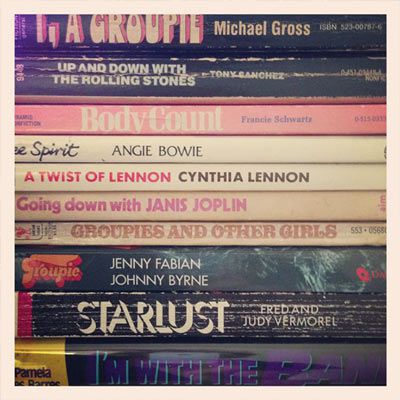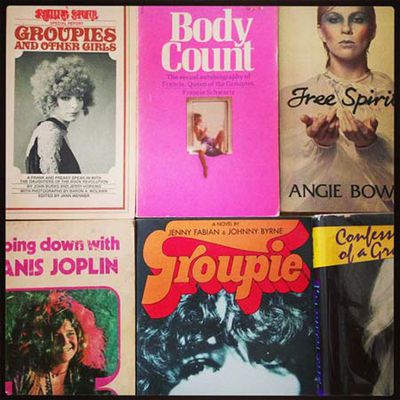Simmone Howell writes on her failed attempt at groupiedom and her beloved collection of band-date paperbacks.
‘Research psychologists say that girls from the ages of 11-14 reach a lifetime high energy peak. Their appetite is insatiable. They never again care about things as much as they do during this period, and minutiae don’t exist for them.’
– Groupies & Other Girls by John Burks and Jerry Hopkins
One summer’s day when I was 13, I dressed in purple baggy pants and a lilac polo shirt and caught the 9.22am train from Ringwood to Flinders Street. I was off to meet The Hooters, an American pop band named not for their manboobs but for their signature instrument, a melodion, which looks like a Casio organ with a mouthpiece attached.
The year was 1985. ‘And We Danced’ was charting and the band had just played Festival Hall. I’d been in the front row, screaming, because everyone knows that’s what you do at pop concerts. There were five Hooters and each wore a different colour. Rob wore white, Eric wore black, Andy wore blue, David wore yellow and John wore red. Rob was my favourite. He looked mouse-ish, nice, non-threatening – what you want at that age.
This was my second attempt at making contact. Two days earlier, I’d set my alarm and snuck out at 5am to wait for the Airport Bus, but my mother had come tearing down Loughnan Rd in her dressing gown, scooping me up and scuppering my plans. Later, after much argument, it was decreed that I could go to the city and attempt to meet the band, but only if my sisters came with me. I had been growing my nails in preparation for the coming of The Hooters. As I sat on the train, I stared at the smooth ovals (painted lavender, with Stop-bite) and thrummed with the knowledge that if I could grow my nails I could do anything.
We camped outside the Rockman’s Regency hotel for most of the day, meeting other fans and exchanging gossip and phone numbers. And then: a sighting. That’s HIM. OVER THERE! Exiting the cafe, wearing sunglasses (of course!).
Our new, more experienced friends stormed the pop star, blocking his path, proffering Violet Crumbles and cling-on koalas and autograph books. I had my photo taken with Rob and John. Rob seemed slightly bored but John signed his autograph with ‘Love’ , put his man-sized arms around me and kissed my cheek for the camera. I had that photo blown up and framed.
In retrospect it looks like a girl getting monstered by some old dude in a bolo tie. But it was the start of something.

Stalking John Justin at a Saturday afternoon sound check, ‘fainting’ to get backstage at Mister Mister, nicking Paul Hester’s phone number from my guitar teacher’s Filofax … over the summer I apprenticed but never managed to get up close and personal. I was too young, too deluded and too, well, tame. You wouldn’t have found me brazenly waving a toothbrush about like that girl at Billy Idol.
Perhaps it was my failed attempt at groupiedom that led to me to collect books by and about fans, groupies, muses, inamoratas and ‘ol ladies. I devoured rock biographies, not because I wanted to read about the musicians, but because I wanted to read about their girlfriends.
Tony Sanchez’s Up and Down With the Rolling Stones had whole chapters on Anita Pallenberg and Marianne Faithfull. A photo of Jim Morrison and his girlfriend Pamela Courson in No One Here Gets Out Alive was, to 14-year-old me, the image of romantic love. I found Rock Wives by Victoria Balfour at the book-swap outside the cobblers at the new Ringwood market. Reading it felt like walking into a lightning field.
There was Myra Lee Lewis (who married Jerry Lee Lewis, her cousin, at age 13) and Suze Rotolo (the girl on Bob Dylan’s arm on the cover of The Freewheelin’ Bob Dylan) and Gail Zappa (whose numb acceptance of her husband’s infidelities boggled my teenage mind). Then there was ‘super-groupie’ Pamela Des Barres’ I’m With the Band, where she detailed her exploits with Jimmy Page etc. in a breathless, stream-of-consciousness style that I echoed in countless ‘Fantasy Time’ notes to friends during veggie maths or unwinding post-exams.
I read Angie Bowie’s Free Spirit and Cynthia Lennon’s A Twist of Lennon. I was disappointed with the G-rated content of Carol Bedford’s Waiting For the Beatles: An Apple Scruff’s Story but made up for it with Body Count: The Sexual Autobiography of Francie, Queen of the Groupies.
Groupie by Jenny Fabian was frank and funny, even if the names had been changed, and Going Down With Janis Joplin by Peggy Caserta was a carnival of smack, smut and feather boas. I was looking for the kind of education I wasn’t going to get from school. I can’t remember how to do fractions but I can tell you that when Cynthia Plaster Caster made a model of Jimi Hendrix’s ‘rig’, despite assiduous ‘plating’, he could only rise to ‘half-mast’ (it was still impressive).

Revisiting my groupie books now is like an invitation to cringe, but I know what I loved about them then. Even in the sordid stories, the dream is there: it’s about freedom and living an unconventional life, of being known-of but not known. It’s about being Ruby Tuesday or Penny Lane and not someone who works part-time after school at Target. It’s about getting so close to the light that it reflects upon you, until one day it might even be you.
Simmone Howell is the author of


